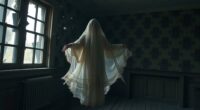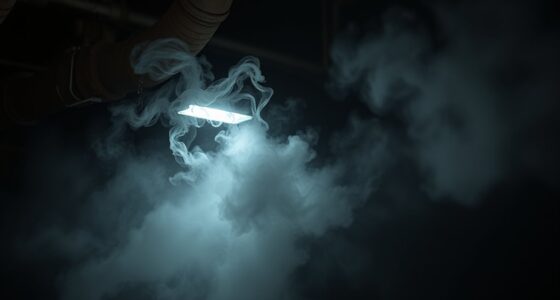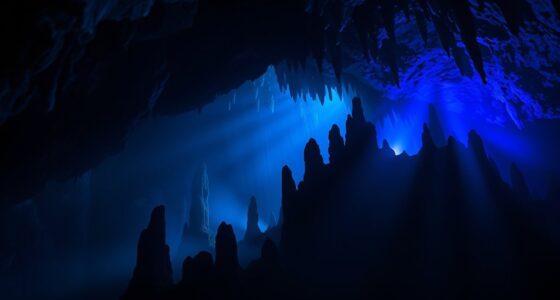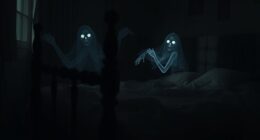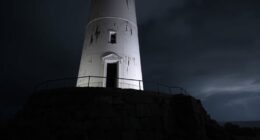Sleep paralysis mimics hauntings because it triggers vivid hallucinations while you’re unable to move. You might see shadowy figures or feel a weight on your chest, creating an intense feeling of being attacked. This experience blurs the line between reality and your mind’s creations, making it easy to interpret these sensations as supernatural encounters. The mix of fear, immobility, and cultural beliefs adds layers to this phenomenon that you might find intriguing to explore further.
Key Takeaways
- Sleep paralysis creates immobility and vivid hallucinations, often resembling ghostly figures or supernatural entities perceived during haunting experiences.
- Cultural beliefs shape the interpretation of sleep paralysis, linking it to supernatural forces, such as devils or spirits, enhancing the haunting experience.
- The brain’s disrupted perception of self during sleep paralysis can blur the lines between reality and hallucinations, mimicking experiences of being haunted.
- Emotional responses, heightened by neurochemical changes during sleep paralysis, can amplify fear and anxiety, similar to feelings during actual haunting encounters.
- The overlap of sensory gaps filled by the brain during paralysis can result in shadowy figures, paralleling common ghostly imagery in hauntings.
The Science Behind Sleep Paralysis

When you find yourself awake but unable to move, you might be experiencing sleep paralysis, a phenomenon that occurs due to a disruption between wakefulness and REM sleep.
Experiencing sleep paralysis means you’re caught between wakefulness and REM sleep, leaving you conscious yet immobile.
During this state, your body experiences temporary muscle atonia, leaving you conscious yet immobile. About 40% of people report vivid hallucinations, often involving shadowy figures or a weight on their chest, which can be chilling.
This occurs partly due to disruptions in the temporoparietal junction, affecting your perception of body image. Additionally, fluctuations in serotonin can intensify these hallucinations, making them feel strikingly real.
Cultural interpretations often link these experiences to supernatural encounters, as your brain fills in perception gaps with familiar narratives, enhancing the eerie nature of sleep paralysis.
Hallucinations: a Window Into the Subconscious

Hallucinations during sleep paralysis can serve as a fascinating glimpse into your subconscious. About 40% of people experiencing REM paralysis report vivid hallucinations, often involving shadowy figures or sensations of being attacked.
These experiences blur your sense of self, making it challenging to distinguish between reality and the mind’s creations. You might see ghosts or even feel as if you’re having out-of-body experiences.
The brain, in a state of confusion, fills in perceptual gaps, leading to these intense hallucinations. Cultural narratives enhance this phenomenon, with many historical accounts describing encounters with devils or spirits.
Neurochemical fluctuations, particularly in serotonin, further amplify the likelihood of these eerie encounters, revealing how deeply intertwined your psyche is with these spectral experiences.
The Role of Brain Structures in Self-Perception

Although you may not realize it, specific brain structures play an essential role in shaping your self-perception, especially during episodes of sleep paralysis. The temporoparietal junction (TPJ) integrates sensory information vital for maintaining body ownership. Disruptions in the TPJ can lead to hallucinations of ghostly figures that mimic your movements, enhancing the eerie feeling of sleep paralysis.
Additionally, the superior parietal lobule helps construct vivid body images, and abnormalities here can distort your self-perception. Weak activity in the prefrontal cortex during REM sleep can blur the line between self and other, intensifying these experiences.
Understanding these brain structures reveals how they contribute to the strange sensations and perceptions you encounter during sleep paralysis.
Neurochemistry and the Experience of Fear
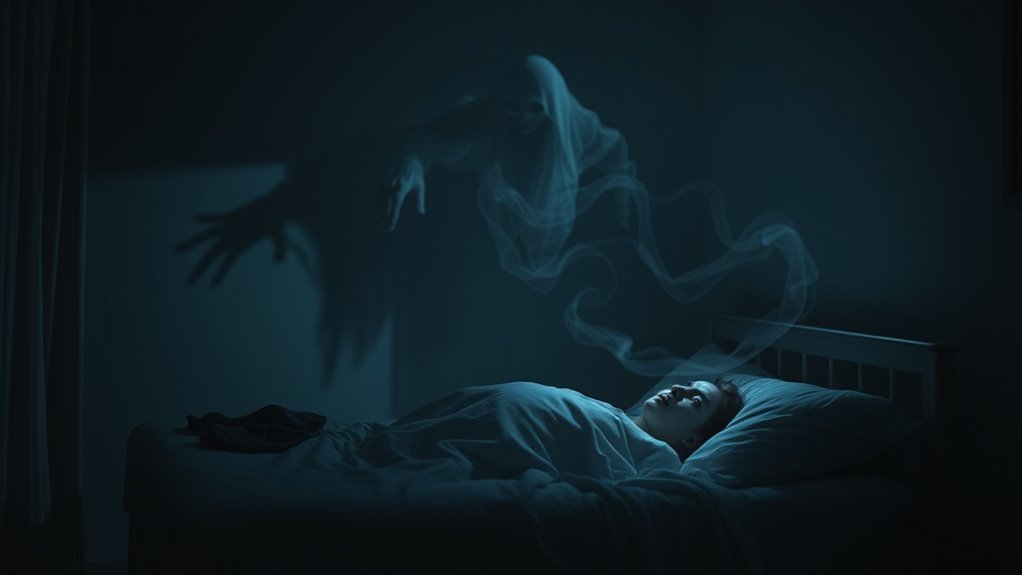
Understanding the role of brain structures sheds light on how neurochemistry influences the experience of fear during sleep paralysis. Here are three key aspects to examine:
- Serotonin Fluctuations: Changes in serotonin levels can heighten emotional responses, intensifying feelings of fear and leading to vivid hallucinations. This heightened emotional state can be similar to the effects experienced during gaslighting in custody battles. Additionally, individuals with borderline personality disorder may experience heightened emotional responses, further complicating their perception of fear.
- Activation of Serotonin 2A Receptors: Over-activation of these receptors amplifies fear, making you more likely to perceive ghostly figures during sleep paralysis.
- Predictive Brain Mechanisms: When sensory feedback is disrupted, your brain fills gaps with simplistic representations, often resulting in shadowy figures that evoke terror. Moreover, the emotional manipulation experienced in narcissistic relationships may contribute to heightened anxiety, potentially exacerbating the fear felt during such episodes.
These neurochemical processes explain why sleep paralysis can feel eerily similar to ghostly encounters, intertwining fear and hallucinations in a profound way.
Cultural Interpretations of Sleep Paralysis and Ghosts

Cultural interpretations of sleep paralysis reveal how deeply our beliefs shape the experience of this phenomenon. Across the globe, people connect these episodes to ghosts and mystical experiences. For instance, in Japan, it’s known as “kanashibari,” while in Newfoundland, folks refer to it as the “Old Hag.” In China, sleep paralysis is termed “ghost oppression,” reflecting the belief in malevolent spirits.
Here’s a summary of various cultural interpretations:
| Culture | Term | Belief | Experience |
|---|---|---|---|
| Japan | Kanashibari | Supernatural forces at play | Out-of-body experience |
| Newfoundland | Old Hag | Witch-like entity suffocating | Pressure on chest |
| China | Ghost Oppression | Malevolent spirits involved | Intense fear |
| Global | Various | Psychological and supernatural blend | Varies widely |
Frequently Asked Questions
What Are Some Creepy Facts About Sleep Paralysis?
Sleep paralysis can be pretty creepy. About 1 in 5 people experience it, often feeling an intense pressure on their chest, like something’s holding you down.
You might see shadowy figures looming nearby, making the experience even more terrifying. Culturally, it’s been linked to encounters with ghosts or devils, like the Japanese “kanashibari.”
Plus, neurochemical changes during these episodes can blur reality, leaving you questioning what you’ve just experienced.
What Is the Folklore of Sleep Paralysis?
Sleep paralysis is steeped in folklore across cultures.
You might hear about “kanashibari” in Japan, where it’s linked to spirit oppression, or the “Old Hag” in Newfoundland, representing a malevolent force.
In China, it’s called “ghost oppression,” highlighting the belief that spirits cause these sensations.
These narratives often emphasize feelings of being attacked or suffocated, reflecting deep cultural interpretations of the eerie experiences people face during sleep paralysis.
What Is Sleep Paralysis Similar To?
Sleep paralysis is similar to a waking nightmare. You might find yourself unable to move or speak while experiencing vivid hallucinations.
Many people report feeling an overwhelming sense of dread, often accompanied by shadowy figures or an unseen presence. This terrifying experience can blur the lines between reality and dreams, causing you to question what’s happening.
It’s a phenomenon that can leave you shaken, much like a ghostly encounter would.
What Is the Most Common Hallucination During Sleep Paralysis?
Did you know that around 40% of people experiencing sleep paralysis report vivid hallucinations?
The most common hallucination you might encounter is the sensation of a shadowy figure or entity in your room. This can feel terrifying, as many describe feelings of being attacked or suffocated.
These intense experiences can leave you shaken, blending the line between reality and nightmare, making it hard to shake off the fear once you awaken.
Conclusion
As you drift off to sleep, you might find yourself caught between dreams and reality, feeling an eerie presence in the room. It’s fascinating how your mind weaves together the threads of science and folklore, making sleep paralysis feel like a ghostly encounter. Surprisingly, what seems like a haunting is really just your brain’s way of processing fear and the unknown. So, next time you experience that chilling stillness, remember: it’s just your mind playing tricks, not a spectral visitor.

